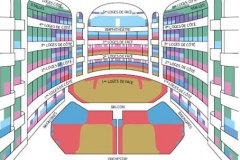Giselle
October 2025 | ||||||
|---|---|---|---|---|---|---|
Mo | Tu | We | Th | Fr | Sa | Su |
Giselle – Jean Coralli, Jules Perrot
Ballet in two acts (1841)
Duration : 2h10 with 1 interval
It begins like a fairy tale: the charming peasant girl Giselle loves a young man who, beneath his rustic attire, turns out to be a duke. Alas! Albrecht – that is his name – cannot marry her because he is already engaged.
Discovering this, Giselle sinks into madness and death. She is taken in by the Wilis, the souls of young girls abandoned by unfaithful lovers. Will she take revenge on Albrecht by luring him to his death, or will love and forgiveness triumph?
First performed in 1841 at the Royal Academy of Music, Jules Perrot and Jean Coralli’s ballet – here adapted by Patrice Bart and Eugène Polyakov – ushered in a new aesthetic in the history of Western dance.
Pointe shoes, arabesques and long white tutus conjure up a fantastical, diaphanous universe that has become the very embodiment of Romanticism.
CHARACTERS
Giselle: A young peasant girl. She falls in love with Loys, who turns out to be Duke Albrecht. Consumed by madness, she dies of a broken heart at the end of Act I.
Albrecht: Duke of Silesia. Already betrothed to Princess Bathilde, he seduces Giselle during the harvest season.
Myrtha: Queen of the Wilis, spirits of young maidens who have died before their wedding day. At night, they lure men into a deadly dance.
Hilarion: The village gamekeeper who is in love with Giselle. He reveals Albrecht’s true identity then dies, punished by the Wilis.
First part
Act 1:
A village in the midst of celebrations
Giselle, a pretty village girl, has fallen in love with a handsome young man who comes from elsewhere. She knows nothing about him. He says his name is Loys. However, Hilarion the gamekeeper, whose shrewdness is made all the sharper by jealousy, suspects that he is a nobleman. Everyone is swept up in the dance. Waltz
Giselle’s mother worries that her daughter’s fragile health will not withstand her passion for dancing and, recounting the fate of the wretched Wilis – maidens who having died before their wedding day are condemned to dance every night until dawn – fears a similar end for her daughter. Giselle laughs off her mother’s concerns and continues dancing with the handsome young man. She is crowned queen of the festivities.
The Peasants’ pas de deux (also known as “the Harversters’ pas-de-deux”)
The Prince of Courland happens to pass through the village with his entourage. He stops in front of Giselle’s house and asks for something to drink. His daughter, Princess Bathilde, is engaged to Albrecht, Duke of Silesia, who is none other than… the young man whom Hilarion has just unmasked, having discovered the coat of arms on the sword of his rival. Giselle – shocked by the revelation – loses her mind and dies.
Second part
Act 2:
The forest at midnight: a tombstone topped with a cross.
Several white shades suddenly streak furtively by, then return. Who are these ethereal creatures? They are the Wilis, the souls of young maidens abandoned by faithless lovers. They reap their revenge luring young men to their death by night in the world of shadows. Myrtha, their queen, gathers them together to welcome a new companion into their midst: Giselle appears, shrouded in a deathly pale veil.
Dance of the Wilis
Albrecht arrives to place flowers on Giselle’s grave. He sees the ghostly-white vision of his beloved floating above him and tries to catch hold of her, but the apparition continually escapes his grasp. Finally, it flees. Entranced, he follows her. The foolhardy Hilarion arrives and the Wilis lead him into a feverish yet fatal dance: he is their first victim of the night. Albrecht is set to suffer the same fate.
Giselle implores Myrtha and the other Wilis to show clemency but they remain inflexible. Condemned to dance until exhaustion, Albrecht finds support in Giselle’s love: momentarily united, they dance desperately. Soon, the first light of day forces the ghosts to flee. Giselle, in turn disappears, leaving Albrecht to real life.
Program and cast
The Paris Opera Ballet Défilé
Only for performances on 30 Sept. and 2 Oct. 2025
The Paris Opera Orchestra
With the participation of the Paris Opera Junior Ballet and Ballet School
Étoiles tutus and tiaras designed by Chanel
Creative team
Hector Berlioz - Music - La Marche, excerpt from "Les Troyens" - act 1
Andrea Quinn - Conductor
Requiem for a rose
Only for performances on 30 Sept. and 2 Oct. 2025
Entry to the repertoire - With the Junior Ballet
Creative team
Annabelle López Ochoa - Choreography
Franz Schubert - Music
Andrea Quinn - Conductor
Tatyana van Walsum - Costume design
Tom Klefstad - Lighting design
Giselle
Ballet in two acts (1841)
Creative team
Jean Coralli - Choreography
Jules Perrot - Choreography
Adolphe Adam - Music(1803-1856)
Théophile Gautier - Libretto
Jules-Henri Vernoy de Saint-GeorgesL - ibretto
Andrea Quinn - Conductor
Patrice Bart - Adaptation
Eugène Polyakov - Adaptation
Alexandre Benois - Set and costume design
Silvano Mattei - Set creation
Claudie Gastine - Costume creation
With the Paris Opera Étoiles, Premières Danseuses, Premiers Danseurs and Corps de Ballet
The Paris Opera Orchestra
Duration : 2h10 with 1 interval
Opening
First part - 55 min
Intermission - 20 min
Second part - 55 min
End
Paris Opera Palace Garnier
RM Europa Ticket GmbH is an officially accredited ticket reseller of/by Opera National de Paris.
Agency number: 4848428
The Paris Opera (French: Opéra de Paris, or simply the Opéra) is the primary opera company of Paris. It was founded in 1669 by Louis XIV as the Académie d'Opéra and shortly thereafter was placed under the leadership of Jean-Baptiste Lully and renamed the Académie Royale de Musique. Classical ballet as we know it today arose within the Paris Opera as the Paris Opera Ballet and has remained an integral and important part of the company. Currently called the Opéra national de Paris, it primarily produces operas at its modern 2700-seat theatre Opéra Bastille which opened in 1989, and ballets and some classical operas at the older 1970-seat Palais Garnier which opened in 1875. Small scale and contemporary works are also staged in the 500-seat Amphitheatre under the Opéra Bastille.
The company's annual budget is in the order of 200 million euros, of which 100 million come from the French state and 70 million from box office receipts. With this money, the company runs the two houses and supports a large permanent staff, which includes the orchestra of 170, a chorus of 110 and the corps de ballet of 150
Each year, the Opéra presents about 380 performances of opera, ballet and other concerts, to a total audience of about 800,000 people (of which 17% come from abroad), which is a very good average seat occupancy rate of 94%In the 2012/13 season, the Opéra presents 18 opera titles (two in a double bill), 13 ballets, 5 symphonic concerts and two vocal recitals, plus 15 other programmes. The company's training bodies are also active, with 7 concerts from the Atelier Lyrique and 4 programmes from the École de Danse.
The Palais Garnier is a 1,979-seat opera house, which was built from 1861 to 1875 for the Paris Opera. It was originally called the Salle des Capucines because of its location on the Boulevard des Capucines in the 9th arrondissement of Paris, but soon became known as the Palais Garnier in recognition of its opulence and its architect, Charles Garnier. The theatre is also often referred to as the Opéra Garnier, and historically was known as the Opéra de Paris or simply the Opéra, as it was the primary home of the Paris Opera and its associated Paris Opera Ballet until 1989, when the Opéra Bastille opened at the Place de la Bastille. The Paris Opera now mainly uses the Palais Garnier for ballet.
The Palais Garnier is "probably the most famous opera house in the world, a symbol of Paris like Notre Dame Cathedral, the Louvre, or the Sacré Coeur Basilica." This is at least partly due to its use as the setting for Gaston Leroux's 1910 novel The Phantom of the Opera and, especially, the novel's subsequent adaptations in films and Andrew Lloyd Webber's popular 1986 musical. Another contributing factor is that among the buildings constructed in Paris during the Second Empire, besides being the most expensive, it has been described as the only one that is "unquestionably a masterpiece of the first rank." This opinion is far from unanimous however: the 20th-century French architect Le Corbusier once described it as "a lying art" and contended that the "Garnier movement is a décor of the grave".
The Palais Garnier also houses the Bibliothèque-Musée de l'Opéra de Paris (Paris Opera Library-Museum). Although the Library-Museum is no longer managed by the Opera and is part of the Bibliothèque nationale de France, the museum is included in unaccompanied tours of the Palais Garnier.

 EN
EN DE
DE IT
IT FR
FR ES
ES RU
RU JP
JP RO
RO
 Seating plan
Seating plan 